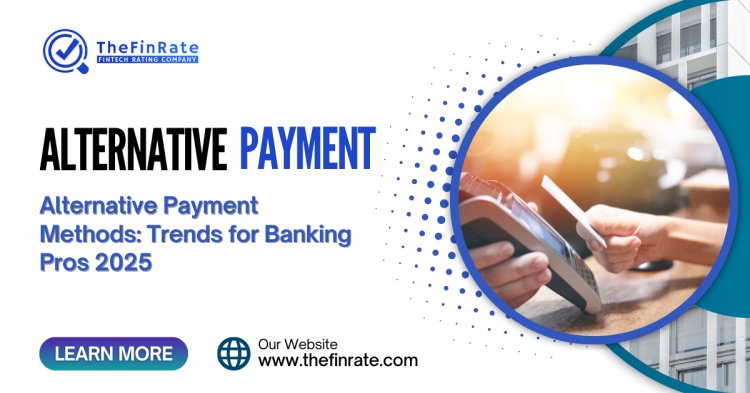Alternative Payment Methods: Trends for Banking Pros 2025
Explore the top alternative payment methods and emerging trends shaping global banking and fintech in 2025.
Share this Post to earn Money ( Upto ₹100 per 1000 Views )

Introduction
In 2025, the payment landscape is rapidly evolving, driven by advances in technology, shifting customer expectations, and a push toward greater financial inclusion. Alternative payment methods are no longer niche options—they’re becoming essential tools that banking professionals must understand to stay competitive and relevant. These innovative payment solutions offer faster, more secure, and more flexible ways for consumers and businesses to transact globally. For banking professionals and technology enthusiasts, staying ahead of the curve in alternative payment trends is critical to enhancing customer experience, reducing risks, and expanding market reach in an increasingly digital economy.
What Are Alternative Payment Methods?
Definition and Overview
Alternative payment methods (APMs) refer to payment options that go beyond traditional credit or debit card transactions and cash. These include digital wallets, bank transfers, buy now, pay later services, cryptocurrencies, and other emerging fintech solutions that cater to diverse consumer preferences and regional needs.
Types of Alternative Payment Methods
-
Digital Wallets: Platforms like Apple Pay, Google Pay, and Samsung Pay that store payment information securely and enable quick mobile payments.
-
Buy Now, Pay Later (BNPL): Services such as Klarna, Afterpay, and Affirm that allow consumers to split purchases into installments without upfront credit checks.
-
Cryptocurrencies and Stablecoins: Bitcoin, Ethereum, and digital currencies pegged to fiat (like USDC) offer decentralized payment options and faster settlements.
-
Bank Transfers and Local Payment Systems: Regional favorites such as UPI in India, iDEAL in the Netherlands, or OXXO in Mexico cater to local preferences and boost conversion rates.
-
Contactless and Biometric Payments: Using NFC technology and biometric authentication (fingerprint, facial recognition) to streamline and secure transactions.
Why Alternative Payment Methods Matter for Banking Professionals in 2025
Enhancing Customer Experience
Customers increasingly demand convenience, speed, and flexibility in their payments. Offering multiple alternative payment methods allows banks to meet diverse needs, from mobile-first generations to international shoppers, improving satisfaction and loyalty.
Expanding Market Reach
Alternative payments open doors to previously underserved or unbanked populations. For example, UPI has revolutionized payments in India, driving digital adoption across rural areas. Banks that integrate these options gain access to fast-growing markets and new revenue streams.
Reducing Transaction Costs and Risks
Many alternative methods feature lower processing fees and advanced security technologies, helping banks reduce operational costs and minimize fraud exposure. AI-driven fraud detection and tokenization are becoming standard features in modern payment systems.
Key Trends in Alternative Payment Methods for 2025
Rise of Buy Now, Pay Later (BNPL)
BNPL has exploded in popularity, especially among younger consumers. For banking professionals, this trend signifies a shift in consumer credit models—offering new ways to engage customers while managing risk through innovative underwriting and automated collections.
Integration of Cryptocurrencies in Mainstream Banking
Banks are increasingly exploring crypto adoption, driven by demand for faster cross-border payments and diversified payment options. Stablecoins, in particular, are gaining traction as they combine cryptocurrency efficiency with price stability, providing new avenues for remittances and payroll.
Increased Use of Real-Time Payments and Instant Settlements
Real-time payment networks are expanding worldwide, enabling instant fund transfers and improving cash flow management. Banks adopting these systems can offer competitive advantages through faster settlements and enhanced liquidity.
Expansion of Mobile and Contactless Payments
With continued growth in mobile penetration and contactless tech, biometric authentication and NFC payments are becoming everyday norms, especially in retail and transportation sectors. These technologies improve payment speed and reduce physical touchpoints—a key post-pandemic preference.
Growing Role of AI and Machine Learning in Payment Processing
AI is transforming payment processing by analyzing transaction patterns to predict fraud, optimize routing, and personalize payment experiences. Banks leveraging these tools can reduce false declines, lower fraud losses, and enhance customer trust.
How Banks Can Leverage Alternative Payment Methods
Partnering with Fintechs and Payment Gateways
Collaborations with fintech companies and payment processors can accelerate the rollout of alternative payment solutions. Fintech partnerships bring agility, innovation, and access to diverse payment methods, which banks can integrate into their ecosystems for seamless customer experiences.
Upgrading Infrastructure for Seamless Payment Experience
Modernizing payment infrastructure with open banking APIs, cloud platforms, and developer-friendly APIs allows banks to quickly adopt new payment types and scale efficiently. This flexibility is crucial in meeting evolving consumer expectations.
Ensuring Compliance and Security
Banks must navigate complex regulations such as PSD2 in Europe, GDPR, and KYC/AML rules globally. Embedding automated compliance checks and adopting robust security standards (PCI DSS, 3D Secure 2.0) help mitigate risks associated with alternative payment adoption.
Challenges and Considerations for Alternative Payment Adoption
Regulatory Uncertainty and Compliance Hurdles
Diverse regional regulations can complicate global alternative payment deployment. Banks need legal expertise and adaptable systems to stay compliant without slowing innovation.
Technology Integration and Legacy Systems
Legacy infrastructure often hampers rapid integration of new payment methods. Banks must invest in modernization or middleware solutions to bridge old systems with new payment technologies.
Customer Trust and Data Privacy Concerns
Building trust is essential when introducing new payment methods. Transparent communication on data usage, strong encryption, and privacy compliance help banks alleviate customer concerns.
The Future Outlook: What Banking Professionals Should Expect Beyond 2025
Alternative payment methods will continue evolving with emerging technologies like blockchain, Internet of Things (IoT), and decentralized finance (DeFi). Personalized, frictionless payments will dominate, while digital identity solutions linked to payments will enhance security and inclusion. Banking professionals who stay proactive in adopting and adapting to these innovations will lead the next wave of financial transformation.
Conclusion
Alternative payment methods are no longer optional—they’re central to the future of banking and commerce. For banking professionals in 2025, understanding and embracing these trends is crucial to driving growth, improving customer experience, and maintaining security. By leveraging partnerships, upgrading infrastructure, and navigating regulatory landscapes, banks can harness the full potential of alternative payments and thrive in a connected global economy.
Discover cutting-edge alternative payment methods, key 2025 trends, and expert insights for banking professionals navigating the future of digital finance—only on TheFinRate.














